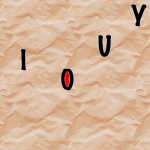Yesterday’s trip through the Danish vowels continues…

O Many foreigners think this is a U, as the two sounds are really close in Danish. The basic O is just a hair’s breadth more open than the basic U: to (two, pronounced somewhere in the middle of too and ”tuh”), skole (school). When short, however, most O’s open up, becoming rather like the English o of colony: at hoppe (to jump), chok [shok] (shock).
U When long, the Danish U sounds like oo of English tool: uge [OO’eh] (week), hule [HOOLeh] (cave). When short, it often sounds like the u of English put: lup (magnifying glass), buttet (chubby). Now and then the short U sounds like a shortened version of the long Å – that is, like the single aw sound of English awful, only a bit shorter: bukser [BᵃʷKsor] (trousers), ung [ᵃʷng] (young).
Y The Y sound does not exist in English. The Danish Y is basically the same as the French u in lune or the German ü in München. To attain it, keep a steady ”ee” sound, then carefully round your lips without changing the position of your teeth or tongue: lys (light), tyve (twenty). The short Y often (but not always) gets an Ø quality. The two words lykke (happiness) and løkke (loop) sound just the same!
Æ Æ sounds like the e of English bet: æsel (donkey), væk (away, gone).
Ø The Ø sound does not exist in English. The Danish Ø is basically the same as the French eu in bleu or the German ö in Döner. To attain it, keep a steady ”eh” sound (as in well), then carefully round your lips without changing the position of your teeth or tongue: øl (beer), at købe (to buy). There’s a lot of variation in the Danish Ø’s; for example the Ø of sød (sweet) is tighter than the Ø of høne (hen), which, in its turn, is tighter than the very open Ø of børn (children). (But don’t spend too much time pondering this!)
Å Å sounds like aw in awesome: ål [awl] (eel). When it’s short, it’s closer to o in on: hånd [hon] (hand).
http://www.youtube.com/watch?v=uXBm9p0AF2Y
Pay attention to the Danish O sound in this classic, Søren Kragh Jacobsen’s ”Kender du det?” (Do you know that?) The girl the singer’s in love with is called Mona, Mona, Mona… (Close to, but not the same as ”Moona, Moona, Moona…” 🙂 )






Comments:
Claudia:
U pronounced as “aw”? Does sound like a special København’s slang version to me…
Bjørn A. Bojesen:
@Claudia Hej Claudia!
Sorry if my way of spelling out sounds in English confuses you!
If you listen to Danes speaking, you’ll hear there’s really no U sound in a word like ”smuk” (beautiful).
People – all over the country – say ”småk” (but keep *writing* the word as s-m-u-k).
But you’re right – ”smuk” isn’t 100 % the same as ”smawk”.
The difference is that English ”aw” (one sound, as in ”hawk”) is long. The å sound of ”smuk” is short.
My pronunciation guide for ”ung” – aw-ng – looks horrible! But as English has no short ”aw” sound, it’s the closest I could get.
If you’ve got another suggestion, I’ll happily accept it! 🙂
Thanks for pointing this out!
Bjørn
Update: I’ve made a change in the text. How does that look to you?